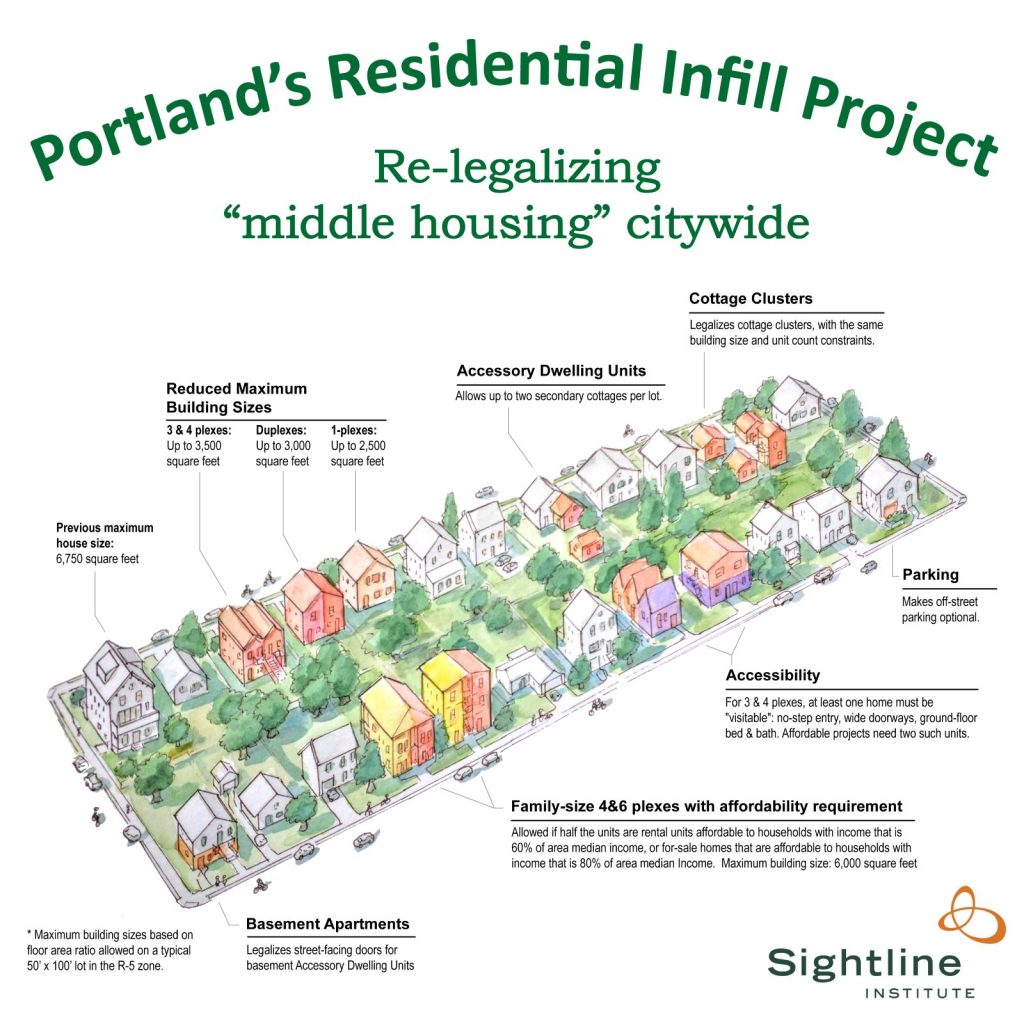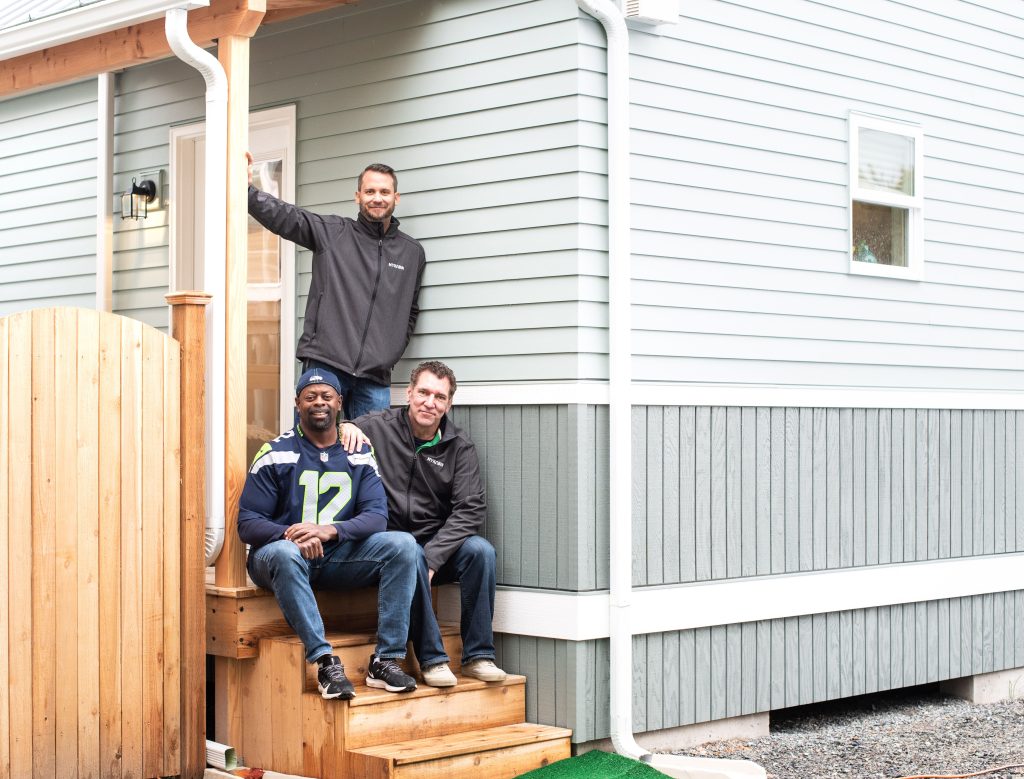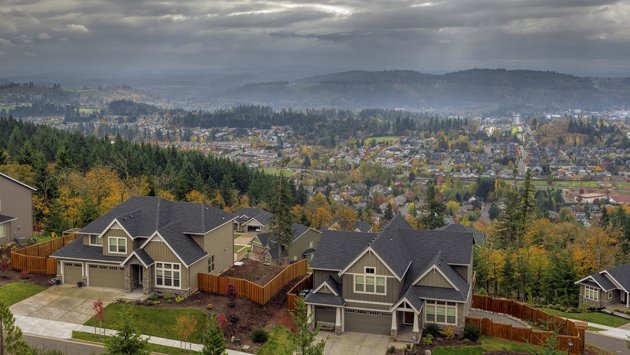Today, Portland did what Seattle has failed to do: grapple with its legacy of exclusionary zoning. Portland City Council voted three to one to allow four homes to be built on any residential lot in the city. As an added incentive to affordable housing developers, if at least half the homes are affordable to low-income residents, the limit increases to six per lot.
Housing advocates have called this a “gamechanger.” Fourplexes, affordable six-unit apartment buildings, and cottage clusters will begin to rise where formerly only expensive mansions had risen previously. Sightline Institute’s Michael Anderson–who advocated to pass the policy–called it the best low-density zoning reform package in the nation.
The reform, which is titled the Residential Infill Project, superseded exclusionary single-family zoning that consumed the overwhelming majority of buildable land in Portland. Seattle similarly has two-thirds of its buildable land set aside for single family homes, but it has yet to pass such far-reaching reform.


Seattle’s recent zoning battles
The Housing Affordability and Livability Agenda (HALA) committee, Seattle Mayor Ed Murray, and the City Council backed away from single family zoning reforms it had been weighing in 2015 following a sharp backlash from homeowners and Seattle Times columnists.
The Seattle City Council advanced accessory dwelling unit (ADU) reform as a replacement, and, after a time-consuming legal challenge, ADU liberalization passed in 2019 and made it easier to add backyard cottages and basement flats to single-family homes. The reform also limited mansion development by capping single-family home square footage at half the lot square footage–not as strict as Portland’s cap, but a start.

Instead of enacting inclusionary zoning in single-family zones, Seattle’s HALA rezones targeted existing multifamily zones with mostly modest increases in zoned capacity starting with urban bastions in the University District and Downtown in 2017. As the City rezoned 27 urban villages in 2019 to implement Mandatory Housing Affordability (MHA) “citywide”, 6% of the city’s single-family zoning was rezoned, but the vast majority remained unaffected.
Portland’s successful model
Portland took a different tact. While its Residential Infill Project also had to make it through years of outreach and process, Portland leaders stuck by the endeavor. Much of the credit goes to advocates who made a very clear and convincing case. Portland: Neighbors Welcome (P:NW) formed to back the reform and doggedly advocated for it.
“After five years of revisions, public hearings, and community feedback, the Residential Infill Project has evolved into a proposal more proportional to the housing challenges that Portlanders face,” Portland: Neighbors Welcome said in a press release.
In his Sightline synopsis, Anderson predicted the infill project would increase housing production more than single-family zoning reform in Minneapolis, Austin, and Seattle’s ADU package, and he credited the incentive allowing progressively larger buildings if more homes and low-income units are included.
“The idea is for that extra square footage to work like a sluice gate for Portland’s housing market, rechanneling investment away from luxury remodels and McMansions and toward new homes that are affordable to the middle class on day one,” Anderson wrote. “Low-density parts of Vancouver and Minneapolis currently have no such distinctions.”
The Portland Bureau of Planning and Sustainability projects the Residential Infill Project will increase housing production by 1,200 homes per year. The City of Seattle projects its recent ADU reform will lead to more than 2,400 additional homes over the next decade. Thus is two years, Portland will build what will take Seattle a decade–if those projections are in the right ballpark.
Rather than staying siloed in a housing advocacy niche, the group took a multifaceted approach.
“Portland has been successful in no small part because policymakers and advocates adopted a ‘yes, and’ approach to housing solutions,” said Trisha Patterson, P:NW Membership Committee Chair. “Portlanders recognized that advancing tenant protections, reforming our zoning codes, and increasing support for regulated-affordable homes are absolutely complementary policy goals.”
What’s next
Seattle housing advocates certainly would like to do what Portland just did. How soon that would be likely is less clear. Some feedback from policymakers has been the next big opportunity for zoning reform is the scheduled major update to the Comprehensive Plan in 2024.
On the other hand, the Seattle City Council is more progressive on land use than it’s been in many decades, and the Seattle Planning Commission laid the ground work in a recent white paper and a 2018 “Neighborhoods for All” report. Moving past the lurching Seattle process of the past could be possible. But we better get a move on soon!
Doug Trumm is publisher of The Urbanist. An Urbanist writer since 2015, he dreams of pedestrian streets, bus lanes, and a mass-timber building spree to end our housing crisis. He graduated from the Evans School of Public Policy and Governance at the University of Washington in 2019. He lives in Seattle's Fremont neighborhood and loves to explore the city by foot and by bike.


